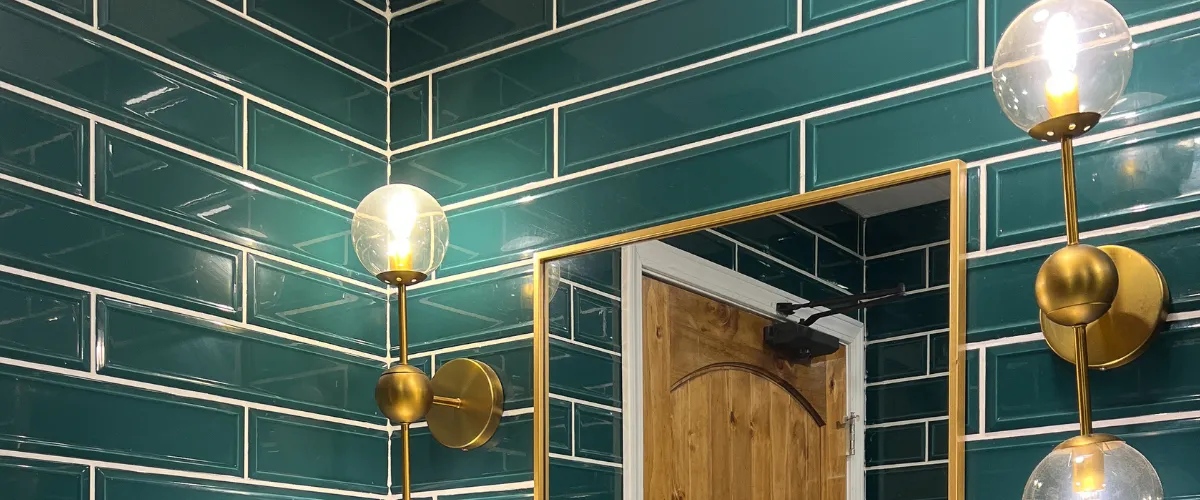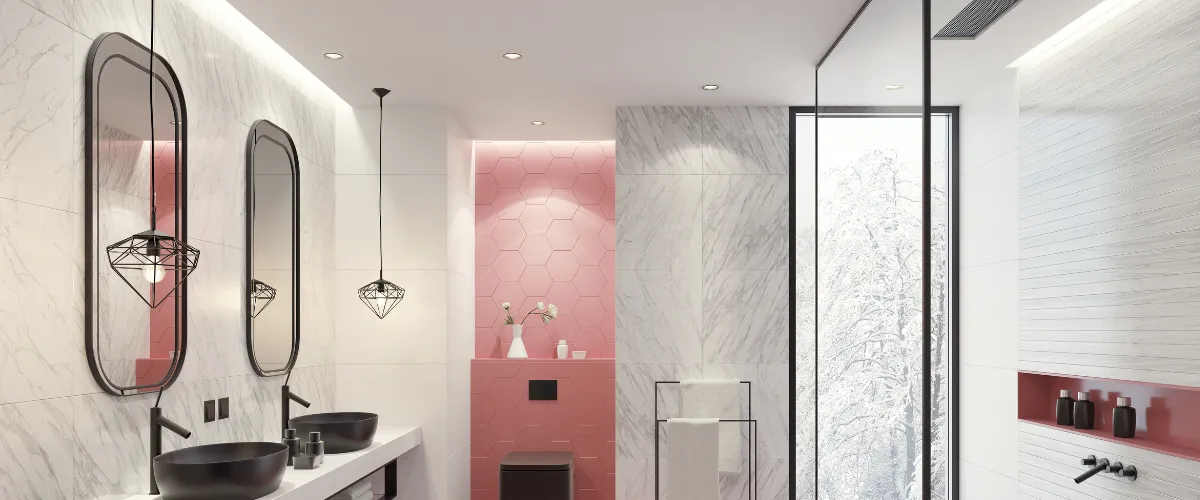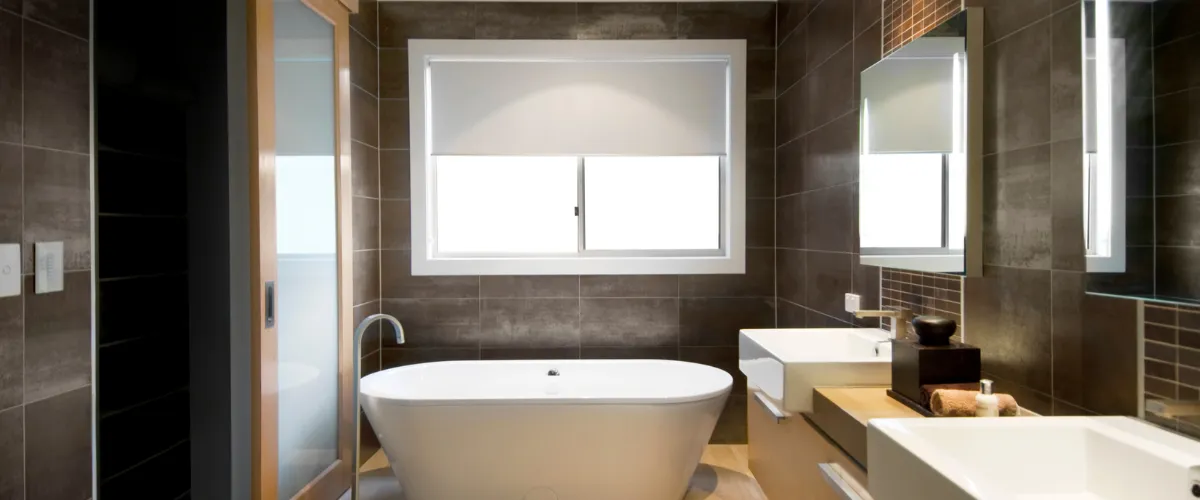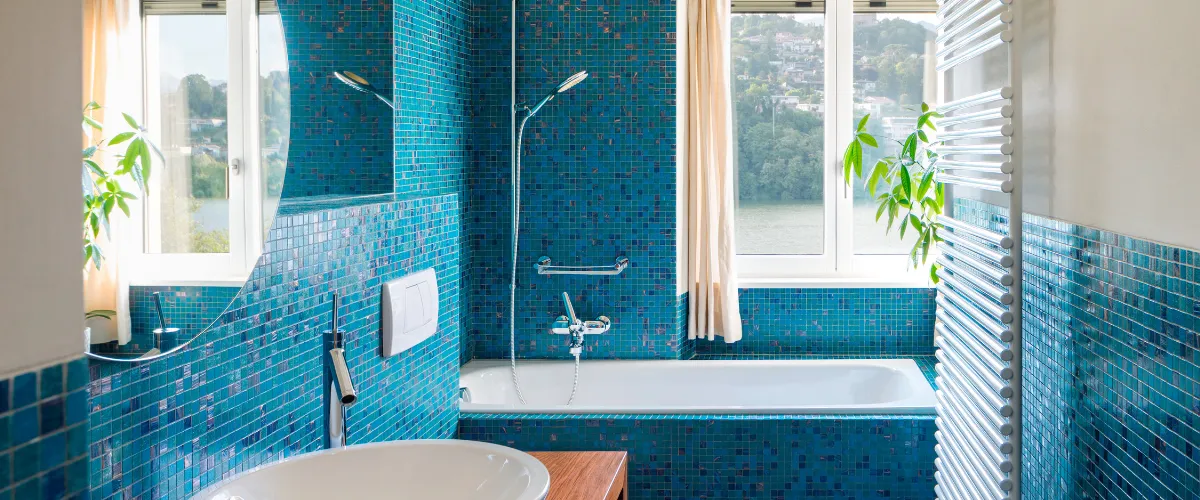Pros And Cons Of High-Contrast Bathroom Tile Designs
Choosing the right bathroom tile design can be tricky. One popular choice is high-contrast bathroom tile designs. This post will cover the good and bad of these designs, helping you decide if they’re right for your space.
Keep reading to learn more!

Key takeaways
- High-contrast tile designs stand out because they mix light and dark colors.
- These tiles come in various patterns such as stripes, geometric shapes, or even floral designs. They can make a space feel dynamic.
- High-contrast designs add texture and depth to any bathroom setting.
- Geometric patterns or encaustic tile designs bring unique style and character to shower floors and accent walls, making them eye-catching features in any bathroom.
Defining High-Contrast Bathroom Tile Designs
Characteristics of high-contrast tile designs
High-contrast tile designs stand out because they mix light and dark colors. This choice draws attention to walls, floors, or focal points in bathrooms. Popular combinations include black and white, navy and white, or grey and cream.
These tiles come in various patterns such as stripes, geometric shapes, or even floral designs. They can make a space feel dynamic.
Porcelain tiles, ceramic tiles, and glass tiles are great for these looks. Each material offers different benefits like durability or shine. Homeowners choose them based on their style preferences and the bathroom’s needs.
High-contrast designs add texture and depth to any bathroom setting.
High-contrast bathroom tile designs transform spaces with bold statements.

Common color combinations and patterns
Moving from the traits that set high-contrast bathroom tile designs apart, let’s focus on the colors and shapes you might see. Black and white are popular choices for creating a bold look.
This classic combo can make your shower walls stand out or give your bathroom floor a timeless feel. Another common pairing is dark tile against light grout, adding dramatic lines to space.
Patterns play a big role too. You might find large format tiles with fewer grout lines for a sleek appearance or small mosaic tiles that add visual interest without overwhelming the room.
Geometric patterns or encaustic tile designs bring unique style and character to shower floors and accent walls, making them eye-catching features in any bathroom.
Pros of High-Contrast Bathroom Tile Designs
Enhances visual interest
High-contrast bathroom tile designs catch your eye. They mix light and dark colors to create a bold look. This can turn shower tiles or floor tiles into art. Your bathroom floors or walls become more than just parts of a room.
They draw attention and make the space unique.
Using contrasting tile patterns makes the room pop. Imagine white grout with black tiles for a classic feel, or gold accents on darker stone for luxury. These choices add character to bathrooms, making them stand out in your home.
Creates a focal point in the bathroom
High-contrast bathroom tile designs can create a focal point in the room, drawing attention and adding visual interest. This effect is heightened when using contrasting color combinations and patterns, such as natural stone with smaller tiles or matte finishes.
The focal point can be strategically placed on areas like shower walls, backsplashes, or flooring to command attention within the overall space.
When implementing high-contrast tile designs in your bathroom, it’s essential to consider how they will serve as a centerpiece for the room while complementing other design elements.
For instance, large-format tiles in bold colors can function as a striking focal point but should be balanced with more neutral tones in surrounding fixtures or decor to avoid overwhelming the space.

Cons of High-Contrast Bathroom Tile Designs
Can overwhelm small spaces
High-contrast bathroom tile designs can be challenging in small spaces. The strong color contrast draws attention, making the room feel confined. Dark grout lines and bold patterns can add to the cramped feeling, especially if the tiles are large.
When working with a petite bathroom, it’s crucial to consider how the high-contrast design will impact the overall visual space. Introducing lighter colored tiles or choosing smaller tile sizes may help mitigate this issue and create a more open feeling.
In small bathrooms, it’s best to avoid using very dark or very light colors for high-contrast designs as they can make the space look even smaller than it is. Choosing smaller tiles can prevent overwhelm and maintain an illusion of spaciousness.
Requires careful matching with bathroom fixtures
Careful matching with bathroom fixtures is crucial when using high-contrast tile designs. The wrong match can lead to a clash with the overall aesthetic, making the space feel overwhelming.
It’s essential to consider the colors and materials of bathroom fixtures such as sinks, faucets, and showerheads before choosing high-contrast tiles. Harmonizing these elements creates a cohesive and visually pleasing bathroom design that doesn’t feel jarring or disjointed.
When selecting high-contrast tiles for your bathroom, consider how they will complement existing fixtures like sinks, faucets, and showerheads. Ensuring a seamless integration between the tiles and fixtures enhances the overall appeal of your bathroom space while maintaining visual harmony throughout.
Best Tile Materials for High-Contrast Designs
Porcelain tiles
Porcelain tiles are a popular choice for high-contrast bathroom designs. They come in various colors, patterns, and finishes, allowing homeowners to create impactful visual effects in their bathrooms.
Porcelain tiles are highly durable and water-resistant, making them suitable for high-traffic areas and steam showers. Moreover, they resist stains and require less maintenance compared to other tile materials.
The low maintenance nature of porcelain tiles makes them cost-effective in the long run while providing a sleek and modern look to the bathroom walls.
Porcelain tiles also offer natural variation that can add depth to the design without overwhelming the space. Their durability and resistance make them well-suited for bathrooms with natural light where they can enhance the overall aesthetic by reflecting light effectively.
When combined with carefully chosen grout color, porcelain tiles can create stunning high-contrast designs that elevate any bathroom space.
Ceramic tiles
High-contrast bathroom tile designs add visual interest and can make your space appear larger. When selecting the right tile material, consider ceramic tiles as a cost-effective option.
They are known for being water-resistant and durable, making them suitable for high-traffic areas in the home. Besides, ceramic tiles offer a variety of color options and patterns that can be tailored to fit your design preference.
When starting a tiling project, homeowners should be aware that ceramic tiles require careful cleaning and maintenance over time. Regular cleaning is essential to preserve their appearance and durability.
Furthermore, in terms of matching with bathroom fixtures, ceramic tiles provide versatility in complementing various design elements within the space.
Maintenance Considerations for High-Contrast Tiles
Cleaning requirements
High-contrast bathroom tiles can be eye-catching, and they also require proper cleaning to maintain their appeal. Whether it’s porcelain, ceramic, or glass, these tiles are water-resistant and ideal for high-traffic areas.
To clean them effectively, use a mild detergent and warm water solution with a soft-bristled brush or mop. It’s crucial to avoid abrasive cleaners as they can damage the tile’s finish.
Regular maintenance is vital to preserve the look and durability of high-contrast bathroom tiles.
When cleaning your high-contrast bathroom tiles, keep in mind that using less grout means easier maintenance. Choose the grout color carefully to avoid discoloration or staining over time.
These steps ensure that your visually striking tile design remains impressive while being easy to maintain in the long run.
Durability and wear over time
High-contrast bathroom tiles like porcelain, ceramic, and glass are durable and resistant to wear. These materials are suitable for high traffic areas where water exposure is common.
Porcelain tiles, known for their strength and resilience, are a good choice for bathrooms due to their resistance to moisture and stains. Ceramic tiles also offer good durability while being cost-effective.
Glass tiles provide a sleek look but may require more careful maintenance.
When choosing high-contrast tiles, homeowners should consider the material’s durability and its ability to withstand wear over time in a moist environment such as the bathroom. Proper care and maintenance can help preserve the appearance of these tiles for years to come.
Regular cleaning routines will keep them looking fresh despite frequent use.

Design Tips for Implementing High-Contrast Tiles
Choosing the right grout color
When selecting the grout color for high-contrast bathroom tiles, consider using a color that complements the tiles. Opt for a grout shade that either blends in seamlessly with the tile or provides a subtle contrast.
This helps to accentuate the design without overpowering it. It is important to note that darker grout tends to hide dirt and stains better than lighter shades, making maintenance easier in the long run.
The right grout color should enhance the overall look of your high-contrast bathroom tile design by harmonizing with the colors and patterns of the tiles rather than competing with them.
Darker shades are often preferred when seeking durability and practicality due to their ability to maintain a clean appearance over time.
Balancing tile size and room dimensions
When choosing high-contrast bathroom tile designs, it’s essential to balance the size of the tiles with the dimensions of your room. Small bathrooms may benefit from larger tiles to create a sense of spaciousness, while larger bathrooms can handle smaller tiles without feeling overwhelmed.
For instance, in small bathrooms, using large-format tiles can minimize grout lines and give the illusion of a more expansive space. On the other hand, in larger bathrooms, smaller tiles can add intricate detail without making the room feel cramped.
Consider how different tile sizes will interact with your room’s dimensions before making a decision. Always take measurements and visualize how various tile sizes will look once installed.
By carefully balancing tile size and room dimensions, you can achieve an aesthetically pleasing result that complements your bathroom space effectively.
Incorporating natural light
Balancing the size and dimensions of your tiles is crucial. To enhance natural light, consider positioning large or full-length mirrors strategically opposite windows to reflect light around the room.
This can create a brighter, more spacious feel in your bathroom – especially when using high-contrast tiles that can reflect and enhance the incoming natural light.
With an array of benefits such as creating a sense of spaciousness and enhancing visual interest, strategic tile placement can significantly impact how natural light interacts with your chosen design scheme.
Strategic use of this free resource not only uplifts aesthetics but also contributes to energy efficiency within the home.
Real-Life Applications
Real-Life Applications:
– Discover a successful high-contrast tile implementation that transformed a small bathroom into an elegant space.
– Explore a less successful example where high-contrast tiles clashed with the overall design, providing valuable insights for your own project.
Example of successful high-contrast tile implementation
One example of a successful high-contrast tile implementation is using large black and white hexagonal tiles on the bathroom floor. The strong difference between the two colors creates a visually striking effect, adding depth and dimension to the space.
The classic combination of black and white also contributes to a timeless and elegant aesthetic that can easily complement various interior styles, making it a versatile choice for homeowners looking to make a statement with their bathroom design.
Besides, the use of large-format tiles minimizes grout lines, resulting in a more seamless and expansive look while reducing maintenance efforts.
In this instance, homeowners chose porcelain tiles due to their durability and water-resistant properties, ensuring longevity in high-moisture environments like bathrooms. By integrating these high-contrast tiles into their design scheme, they were able to achieve an impactful focal point without overwhelming the space or clashing with other elements.
This successful execution demonstrates how thoughtful selection and placement of high-contrast tiles can elevate the overall aesthetic of a bathroom while offering practical benefits for homeowners seeking both style and functionality.
Overview of a less successful example
Transitioning from successful to less successful examples, it’s essential to be mindful of potential pitfalls in high-contrast tile designs. For instance, when opting for high-contrast bathroom tiles, homeowners should carefully consider the dimensions and layout of their spaces.
A less successful example could involve using overly bold and contrasting tiles in a small or cramped bathroom. This may result in overpowering the space, creating an uncomfortable or claustrophobic feel despite the intention to make a design statement.
In another scenario, mismatched high-contrast tiles can clash with other elements in the bathroom such as fixtures and accessories, detracting from the overall aesthetic appeal rather than enhancing it.
It is important for homeowners to ensure that their choice of high-contrast tile designs complements existing elements within their bathrooms while adding visual interest.
Best Manufacturers of High-Contrast Bathroom Tiles
- Daltile: Known for innovative designs and a vast selection that caters to modern bathroom aesthetics and quality needs.
- Porcelanosa: Offers luxurious and high-quality tile solutions with cutting-edge designs perfect for upscale interior projects.
- Marazzi: Renowned for stylish tiles that blend European craftsmanship with durability, ideal for striking and functional bathroom spaces.
- Florim: Provides premium ceramic tiles with an emphasis on sophisticated style and eco-friendly production processes.
- Ragno: Offers a diverse range of classic and contemporary styles, delivering high performance and aesthetic appeal.
Frequently Asked Questions
Why Choose Our Experienced Team
Our team has years of experience in delivering exceptional tile design services, ensuring top-quality results. Partner with industry experts to save money long-term and achieve your dream bathroom. Ready to begin your bathroom remodeling project? Contact us at (816) 200-7741.
